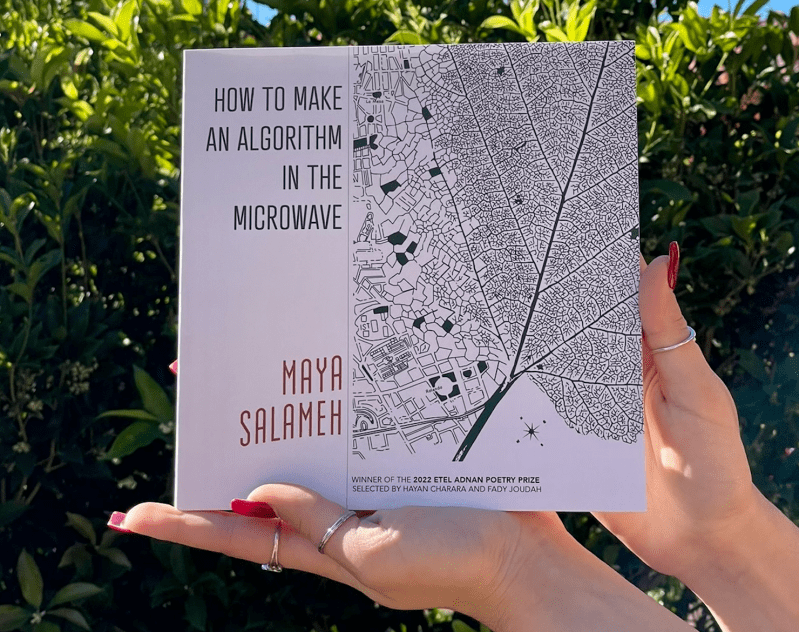Former Diversity in the Arts (IDA) fellow and community organizer Maya Salameh ’22 has begun an inspiring legacy, becoming a decorated poet with only two collections already released. They became the youngest winner of the Etel Adnan Poetry Prize and have been awarded fellowships from the William Male Foundation, the Institute for Diversity in the Arts, the Markaz Resource Center and Martha’s Vineyard Institute of Creative Writing.
Salameh began writing their award-winning poetry collection, “How to Make an Algorithm in the Microwave,” at the start of quarantine in March 2020. With the start of online classes and long days spent in their room, Salameh had more time to develop an intentional relationship with their poetry practice.
“The collection started as a themed collection around the alphabet,” Salameh said. ”Eventually, as I spent months in front of my computer it got me thinking more about technology and the relationships we develop with our devices”
The poetry collection explores the interrelatedness of technology, cities and girlhood. Specifically regarding their experiences being brought up as an Arab American woman, Salameh reflects on the way digital technologies have become deeply intertwined with everyday life.
“Growing up post 9/11 feeling constantly gazed upon, watched and surveilled and how all of those things are intimate,” they said. “The way our devices are somehow both surveillance machines and also confidants — something about that was really interesting to me, especially as a surveilled body.”
Salameh sought to create a poetry collection that explored the ways structures can be challenged and reimagined. Their collection incorporates scientific structures such as Punnett squares and recursion, even featuring a poem written in the shape of HTML code.
“I grew up multilingual, meaning I inherently question language structures,” Salameh said. “It has made me very curious about form and the ways that it can be bent to our will — especially scientific and technological forms, which have been used to medicalize, pathologize or otherwise police surveilled bodies like mine.”
Stanford’s environment and the heavy presence of Silicon Valley also influenced Salameh to explore the political implications of algorithms in society.
Further, their journey creating and publishing their poetry collection as a woman of color with no formal artistic training taught them to be confident in their work, putting it out in the world and overcoming the White gaze.
“As an Arab woman and a queer writer of color, so often in the publishing world I’m made to feel that my work is solely ‘identity’ work, or that I’m relegated to being an ‘identity‘ poet. Sometimes I allow that to gaslight me into thinking that I shouldn’t be telling my story the way it organically occurs or questioning my work. But I remind myself that’s just white gaze burning itself back into my head.”
A-lan Holt, director of the Institute for Diversity in the Arts, was struck by the impact and messages Salameh’s poetry conveys: “Maya’s poetry is brave, sharp and magically vulnerable. Reading their work is like spending deep time with yourself. The lessons learned within their poetry can be carried onward for a lifetime.”
As for Salameh, they found the IDA fellowship an incredibly validating space that “brought more intentionality and gratitude” into their practice. They added that the creative community was a place for them to build lasting creative relationships and learn more about other art mediums.
The IDA fellowship allows artists to look in on each other’s craft and build a community of collaboration and exploration. Former IDA fellow Huong Nguyen ’22 treasures Salameh’s contributions to the IDA community.
“Maya Salameh’s creative spirit is truly contagious, already having touched the hearts and minds of so many during their time at Stanford and beyond,” Nguyen said, “Whether it be the countless hours spent experimenting with new forms, or all they’ve done to support the working ground on diversity in the arts, the impact of Maya’s contributions can never be understated.”
Above all, Salameh values the confidence they developed through their experience — when asked about advice they wished to convey to rising poets, they shared, “I always tell people who are starting in their art practices to send your work out. Put your work out there because you believe in it. The most powerful thing you can do as an artist is send your work out even if you don’t think it’s perfect. You send it out and you let the world respond to it and your work changes in that travel as well. It goes through different drafts and that’s okay; allow the process instead of chasing perfection.”
